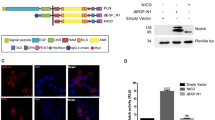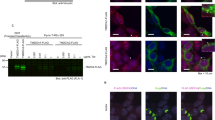Abstract
The Notch receptor and its ligands are key components in a core metazoan signaling pathway that regulates the spatial patterning, timing and outcome of many cell-fate decisions. Ligands contain a disulfide-rich Delta/Serrate/LAG-2 (DSL) domain required for Notch trans-activation or cis-inhibition. Here we report the X-ray structure of a receptor binding region of a Notch ligand, the DSL-EGF3 domains of human Jagged-1 (J-1DSL-EGF3). The structure reveals a highly conserved face of the DSL domain, and we show, by functional analysis of Drosophila melanogster ligand mutants, that this surface is required for both cis- and trans-regulatory interactions with Notch. We also identify, using NMR, a surface of Notch-1 involved in J-1DSL-EGF3 binding. Our data imply that cis- and trans-regulation may occur through the formation of structurally distinct complexes that, unexpectedly, involve the same surfaces on both ligand and receptor.
This is a preview of subscription content, access via your institution
Access options
Subscribe to this journal
Receive 12 print issues and online access
$189.00 per year
only $15.75 per issue
Buy this article
- Purchase on Springer Link
- Instant access to full article PDF
Prices may be subject to local taxes which are calculated during checkout





Similar content being viewed by others
References
Artavanis-Tsakonas, S., Rand, M.D. & Lake, R.J. Notch signaling: cell fate control and signal integration in development. Science 284, 770–776 (1999).
Lai, E.C. Notch signaling: control of cell communication and cell fate. Development 131, 965–973 (2004).
Milner, L.A., Kopan, R., Martin, D.I. & Bernstein, I.D. A human homologue of the Drosophila developmental gene, Notch, is expressed in CD34+ hematopoietic precursors. Blood 83, 2057–2062 (1994).
Nyfeler, Y. et al. Jagged1 signals in the postnatal subventricular zone are required for neural stem cell self-renewal. EMBO J. 24, 3504–3515 (2005).
McKenzie, G.J. et al. Notch signalling in the regulation of peripheral T-cell function. Semin. Cell Dev. Biol. 14, 127–134 (2003).
Hansson, E.M., Lendahl, U. & Chapman, G. Notch signaling in development and disease. Semin. Cancer Biol. 14, 320–328 (2004).
Blaumueller, C.M., Qi, H., Zagouras, P. & Artavanis-Tsakonas, S. Intracellular cleavage of Notch leads to a heterodimeric receptor on the plasma membrane. Cell 90, 281–291 (1997).
Logeat, F. et al. The Notch1 receptor is cleaved constitutively by a furin-like convertase. Proc. Natl. Acad. Sci. USA 95, 8108–8112 (1998).
Sanchez-Irizarry, C. et al. Notch subunit heterodimerization and prevention of ligand-independent proteolytic activation depend, respectively, on a novel domain and the LNR repeats. Mol. Cell. Biol. 24, 9265–9273 (2004).
Gordon, W.R. et al. Structural basis for autoinhibition of Notch. Nat. Struct. Mol. Biol. 14, 295–300 (2007).
Nichols, J.T. et al. DSL ligand endocytosis physically dissociates Notch1 heterodimers before activating proteolysis can occur. J. Cell Biol. 176, 445–458 (2007).
Parks, A.L., Klueg, K.M., Stout, J.R. & Muskavitch, M.A. Ligand endocytosis drives receptor dissociation and activation in the Notch pathway. Development 127, 1373–1385 (2000).
Mumm, J.S. et al. A ligand-induced extracellular cleavage regulates γ-secretase-like proteolytic activation of Notch1. Mol. Cell 5, 197–206 (2000).
Schroeter, E.H., Kisslinger, J.A. & Kopan, R. Notch-1 signalling requires ligand-induced proteolytic release of intracellular domain. Nature 393, 382–386 (1998).
Jarriault, S. et al. Signalling downstream of activated mammalian Notch. Nature 377, 355–358 (1995).
de Celis, J.F. & Bray, S. Feed-back mechanisms affecting Notch activation at the dorsoventral boundary in the Drosophila wing. Development 124, 3241–3251 (1997).
Franklin, J.L. et al. Autonomous and non-autonomous regulation of mammalian neurite development by Notch1 and Delta1. Curr. Biol. 9, 1448–1457 (1999).
Glittenberg, M., Pitsouli, C., Garvey, C., Delidakis, C. & Bray, S. Role of conserved intracellular motifs in Serrate signalling, cis-inhibition and endocytosis. EMBO J. 25, 4697–4706 (2006).
Micchelli, C.A., Rulifson, E.J. & Blair, S.S. The function and regulation of cut expression on the wing margin of Drosophila: Notch, Wingless and a dominant negative role for Delta and Serrate. Development 124, 1485–1495 (1997).
Sakamoto, K., Ohara, O., Takagi, M., Takeda, S. & Katsube, K. Intracellular cell-autonomous association of Notch and its ligands: a novel mechanism of Notch signal modification. Dev. Biol. 241, 313–326 (2002).
Fleming, R.J. Structural conservation of Notch receptors and ligands. Semin. Cell Dev. Biol. 9, 599–607 (1998).
Rebay, I. et al. Specific EGF repeats of Notch mediate interactions with Delta and Serrate: implications for Notch as a multifunctional receptor. Cell 67, 687–699 (1991).
Hambleton, S. et al. Structural and functional properties of the human notch-1 ligand binding region. Structure 12, 2173–2183 (2004).
Abbott, R.J. et al. Structural and functional characterization of a novel T cell receptor co-regulatory protein complex, CD97–CD55. J. Biol. Chem. 282, 22023–22032 (2007).
Henderson, S.T., Gao, D., Christensen, S. & Kimble, J. Functional domains of LAG-2, a putative signaling ligand for LIN-12 and GLP-1 receptors in Caenorhabditis elegans. Mol. Biol. Cell 8, 1751–1762 (1997).
Shimizu, K. et al. Mouse Jagged1 physically interacts with Notch2 and other notch receptors. Assessment by quantitative methods. J. Biol. Chem. 274, 32961–32969 (1999).
Tax, F.E., Yeargers, J.J. & Thomas, J.H. Sequence of C. elegans lag-2 reveals a cell-signalling domain shared with Delta and Serrate of Drosophila. Nature 368, 150–154 (1994).
Salmon, D. et al. Solution structure and backbone dynamics of the Trypanosoma cruzi cysteine protease inhibitor chagasin. J. Mol. Biol. 357, 1511–1521 (2006).
Cordle, J. et al. Localization of the Delta-like-1-binding site in human Notch-1 and its modulation by calcium affinity. J. Biol. Chem. 283, 11785–11793 (2008).
Panin, V.M., Papayannopoulos, V., Wilson, R. & Irvine, K.D. Fringe modulates Notch-ligand interactions. Nature 387, 908–912 (1997).
Kohsaka, T. et al. The significance of human jagged 1 mutations detected in severe cases of extrahepatic biliary atresia. Hepatology 36, 904–912 (2002).
Warthen, D.M. et al. Jagged1 (JAG1) mutations in Alagille syndrome: increasing the mutation detection rate. Hum. Mutat. 27, 436–443 (2006).
Bruckner, K., Perez, L., Clausen, H. & Cohen, S. Glycosyltransferase activity of Fringe modulates Notch-Delta interactions. Nature 406, 411–415 (2000).
Moloney, D.J. et al. Fringe is a glycosyltransferase that modifies Notch. Nature 406, 369–375 (2000).
Xu, A. et al. In vitro reconstitution of the modulation of Drosophila notch-ligand binding by fringe. J. Biol. Chem. 282, 35153–35162 (2007).
Acar, M. et al. Rumi is a CAP10 Domain glycosyltransferase that modifies Notch and is required for Notch signaling. Cell 132, 247–258 (2008).
Muranyi, A. et al. 1H, 13C, and 15N resonance assignments of human Notch-1 calcium binding EGF domains 11–13. J. Biomol. NMR 29, 443–444 (2004).
Hutchinson, S. et al. Molecular effects of homocysteine on cbEGF domain structure: insights into the pathogenesis of homocystinuria. J. Mol. Biol. 346, 833–844 (2005).
Vonrhein, C., Blanc, E., Roversi, P. & Bricogne, G. Automated structure solution with autoSHARP. Methods Mol. Biol. 364, 215–230 (2007).
de La Fortelle, E. & Bricogne, G. Maximum-likelihood heavy-atom parameter refinement for multiple isomorphous replacement and multiwavelength anomalous diffraction methods. Methods Enzymol. 276, 472–494 (1997).
McRee, D.E. XtalView/Xfit—a versatile program for manipulating atomic coordinates and electron density. J. Struct. Biol. 125, 156–165 (1999).
Blanc, E. et al. Refinement of severely incomplete structures with maximum likelihood in BUSTER-TNT. Acta Crystallogr. D Biol. Crystallogr. 60, 2210–2221 (2004).
Vagin, A. & Teplyakov, A. MOLREP: an automated program for molecular replacement. J. Appl. Crystallogr. 30, 1022–1025 (1997).
Rao, Z. et al. The structure of a Ca2+-binding epidermal growth factor-like domain: its role in protein-protein interactions. Cell 82, 131–141 (1995).
Fleming, R.J., Scottgale, T.N., Diederich, R.J. & Artavanis-Tsakonas, S. The gene Serrate encodes a putative EGF-like trans membrane protein essential for proper ectodermal development in Drosophila melanogaster. Genes Dev. 4, 2188–2201 (1990).
Brand, A.G., Manoukian, A.S. & Perrimon, N. Ectopic expression in Drosophila. Methods Cell Biol. 44, 635–654 (1994).
Speicher, S.A., Thomas, U., Hinz, U. & Knust, E. The Serrate locus of Drosophila and its role in morphogenesis of the wing imaginal discs: control of cell proliferation. Development 120, 535–544 (1994).
Mazaleyrat, S.L. et al. Down-regulation of Notch target gene expression by Suppressor of deltex. Dev. Biol. 255, 363–372 (2003).
Thomas, U., Jonsson, F., Speicher, S.A. & Knust, E. Phenotypic and molecular characterization of SerD, a dominant allele of the Drosophila gene Serrate. Genetics 139, 203–213 (1995).
Fehon, R.G. et al. Molecular interactions between the protein products of the neurogenic loci Notch and Delta, two EGF-homologous genes in Drosophila. Cell 61, 523–534 (1990).
Klueg, K.M., Alvarado, D., Muskavitch, M.A. & Duffy, J.B. Creation of a GAL4/UAS-coupled inducible gene expression system for use in Drosophila cultured cell lines. Genesis 34, 119–122 (2002).
Lieber, T. et al. Single amino acid substitutions in EGF-like elements of Notch and Delta modify Drosophila development and affect cell adhesion in vitro. Neuron 9, 847–859 (1992).
Dominguez, C., Boelens, R. & Bonvin, A.M. HADDOCK: a protein-protein docking approach based on biochemical or biophysical information. J. Am. Chem. Soc. 125, 1731–1737 (2003).
Baker, N.A., Sept, D., Joseph, S., Holst, M.J. & McCammon, J.A. Electrostatics of nanosystems: application to microtubules and the ribosome. Proc. Natl. Acad. Sci. USA 98, 10037–10041 (2001).
Acknowledgements
We thank M. Walsh at BM14, the staff of ID29 at the European Synchrotron Radiation Facility and E. Lowe (University of Oxford) for assistance with X-ray data collection. We also thank A. McMichael, S. Hambleton & X. Xu (University of Oxford) for advice and Global Phasing for access to a beta version of Buster-TNT. We thank R. Fleming (Trinity College, Connecticut), C. Wesley (University of Vermont) and S. Artavanis-Tsakonas of Harvard Medical School for D. melanogaster cDNA constructs and fly stocks. This work was supported by the Edward Penley Abraham Cephalosporin fund (#CF065 to S.M.L.), the UK Medical Research Council (MRC; #G0400389 to S.M.L., #G000164 to P.A.H. and MRC Studentship G78/7267 to J.C.), the Wellcome Trust (#077082 to S.M.L., #078765 to P.A.H. and S.M.L. and #079440 to C.R.) and the UK Biotechnology and Biological Sciences Research Council (#C503162/1 and E002285/1 to M.B.).
Author information
Authors and Affiliations
Contributions
J.C. cloned, expressed and functionally characterized J-1DSL-EGF3 and N-111–13 constructs. S. Johnson, S.M.L. and P.R. solved the structure of J-1 and, with J.Z.Y.T., the structure of N-1. J.Z.Y.T. produced 15N-labeled N-1 and, with C.R., performed the NMR experiments and analyzed the data. S. Johnson, S.M.L. and P.A.H. generated functional hypotheses on the basis of the structures; S. Jensen mutagenized Serrate. P.W. produced J-1 for NMR studies, mutagenized J-1 and performed pull-down assays to characterize the mutants. B.J. generated the N-1 monoclonal antibody. M.W., B.H.-D., H.S. and M.B. performed and analyzed experiments in D. melanogaster. S. Johnson, M.B., C.R., S.M.L. and P.A.H. wrote the manuscript.
Corresponding authors
Supplementary information
Supplementary Text and Figures
Supplementary Figures 1–7, Supplementary Results and Supplementary Methods (PDF 1290 kb)
Rights and permissions
About this article
Cite this article
Cordle, J., Johnson, S., Zi Yan Tay, J. et al. A conserved face of the Jagged/Serrate DSL domain is involved in Notch trans-activation and cis-inhibition. Nat Struct Mol Biol 15, 849–857 (2008). https://doi.org/10.1038/nsmb.1457
Received:
Accepted:
Published:
Issue Date:
DOI: https://doi.org/10.1038/nsmb.1457
This article is cited by
-
Mutations observed in somatic evolution reveal underlying gene mechanisms
Communications Biology (2023)
-
Affinity-matured DLL4 ligands as broad-spectrum modulators of Notch signaling
Nature Chemical Biology (2023)
-
Rare variant analysis in eczema identifies exonic variants in DUSP1, NOTCH4 and SLC9A4
Nature Communications (2021)
-
Association of Jagged1 expression with malignancy and prognosis in human pancreatic cancer
Cellular Oncology (2020)
-
Notch signaling in astrocytes mediates their morphological response to an inflammatory challenge
Cell Death Discovery (2019)



